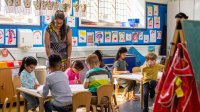Using the Reggio Emilia ‘Image of the Child’ in Your Classroom
Any preschool teacher can use this concept to help build strong connections with students and create authentic learning experiences.
Your content has been saved!
Go to My Saved Content.When do you feel your best? Maybe it’s when you’re eating and exercising well or when you’re on top of your schedule and feel organized. What about when you get some positive feedback about some work you’ve done? It could also happen when you feel validated for something you think, something you said, or something you did.
Most people want to be seen. They want to feel valued and heard. They want to feel important and know that they matter. I know that when I get any feedback or if I know the person I am speaking to appreciates and respects me, I feel valued and loved and I believe in myself more.
Helping Children Know They’re Important
Children want the same things. They want to know that they matter. They want to know that their ideas matter. They want to know that they are seen as capable by the people around them.
One way to demonstrate this to students is to use the Reggio Emilia concept called the “image of the child.” It’s essentially what you believe about children. This concept is at the core of what they do and why they do it. Reggio Emilia’s website says their approach is “an educational philosophy based on the image of a child with strong potential for development and a subject with rights, who learns through the hundred languages belonging to all human beings, and grows in relations with others.”
Having a strong image of the child provides opportunities for you to connect better, to go deeper, and to have authentic experiences with the children around you.
Here are three ways you can begin to show a strong image of the child for your students every day:
1. Create your image. Reflecting is important. Take the time to think about what you believe about children, and then say it out loud, write it down, place it somewhere you can access it (on your easiest and hardest days), and see that your image of children is what guides you. As teachers, we wear lots of hats and are asked to do a lot, so when we can go back and focus on what’s at the core of what we do, then we’re able to re-center and remember what is most important—the child.
2. Make your image a reality. If you say that you believe children are capable, competent, and creative, then your classroom environment will show that. It will be filled with items that support your beliefs. The space will be organized, and it will be filled with the students’ words, photographs, and work. You’ll ask the students to do purposeful and meaningful work because you believe that they have the right to it, and you’ll make sure to honor their thoughts, ideas, and voices.
When I say purposeful and meaningful work, I mean work that has meaning, like writing and making posters to share what we have learned about taking care of the Earth. Another example of purposeful work is to learn what the child is interested in and then providing books on that topic for their reading time.
3. Make the hundred languages possible. Loris Malaguzzi from the Reggio Emilia schools wrote a poem years ago that explains the hundred languages—the idea that children have many ways to express themselves. No child learns the exact same way as their classmates. In school, we often think about how to differentiate work so that our students have a variety of access points in order to gain a better understanding of content.
Children have so many ways to express themselves and to create new understanding. It’s our responsibility as teachers to give them plenty of possibilities to do that.
Making Relationships a Priority
One of the biggest ways to create a strong image of the child is to build relationships with each child in your class. Get to know them. What do they like? Do they have any siblings? What do they like to do for fun? How do they like to learn? When we take the time to get to know the children in our setting, we can learn how to best support them and find those possibilities for optimal engagement and construction of understanding.
One year, before school started, I was speaking with a student who would be in my class. I found out that she loved ninjas and karate. So, as I was preparing the space for her and the other students, I placed a book about karate into her reading bag. On the first day of school, when she reached into her bag and noticed that karate book, she looked at me with such excitement that it brought a smile to our faces. She felt seen and heard.
When they can feel it, say it, and know that we believe in them for who they are (just as they are), children will start or continue to believe it themselves. They’ll know that they are capable of anything they put their mind to, and that is when the magic happens. That is when the wonder happens. That is when children say to themselves, “I am seen, I am valued, I am loved.”
